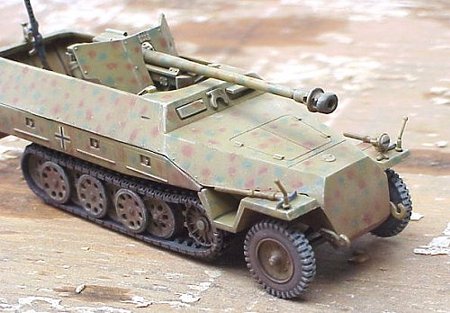Sd.Kfz.
251/22 Ausf. D
Manufacturer:
Hasegawa (Kit #
31145/MT45)
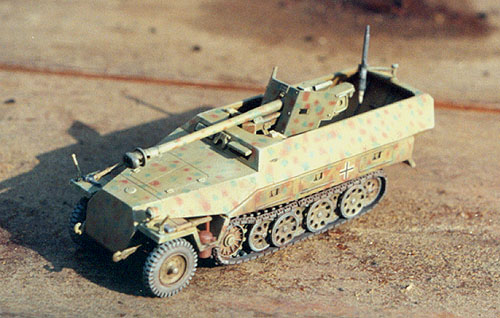
I was very
excited when Hasegawa began releasing their series of Sd.Kfz. 251
Ausf. D kits. These were very important vehicles during the war,
and until now, the only one available in 1/72nd scale was by
Al.By. Although a fantastic kit itself, it is both expensive and
hard to find. Not so with the new Hasegawa kits. They are all
very reasonably priced, and also quite common.
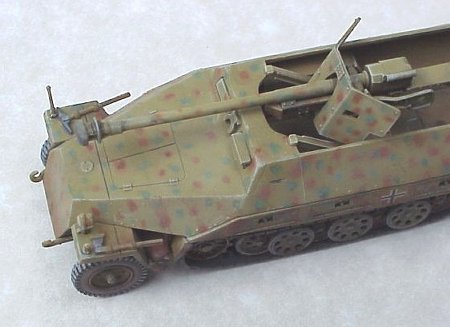
Kit
Strengths
- I
have measured the kit against the dimensions and plans
included in the Wydawnictwo Militaria and the Osprey New
Vanguard books, and according to those two references,
this kit is exactly 1/72nd scale.
- The
overall level of detail on the model is very good. In
particular, the drivers compartment comes complete with a
detailed dash board, radio, gear shift levers, steering
wheel, and even the pattern of springs on the back of the
driver's seat. The wheels are exceptionally
well-detailed, the undercarriage is very crisply molded,
and the MG-42's are also very nice (although the stocks
are a little thick - I sanded mine down some to make it
thinner).
- The
cannon is better than the ESCI PAK 40, although the
inside surface of the shield is bare, where there should
be numerous details. The main deficiency I see is that
the recoil slide (I'm not sure the correct name for this)
is molded solid, where it should have a hollow groove
down its center.
- The
interior of the fighting compartment includes many
details, including the mounting support for the cannon,
ammunition box, crew bench (with open storage compartment
behind the bench), fire extinguisher, and a detailed
floor. The inside of the rear door has the latches molded
on.
- The
driver's armored visor can be open or closed.
- The
kit instructions are up to the usual Hasegawa high
standards, and include an excellent painting and marking
guide.
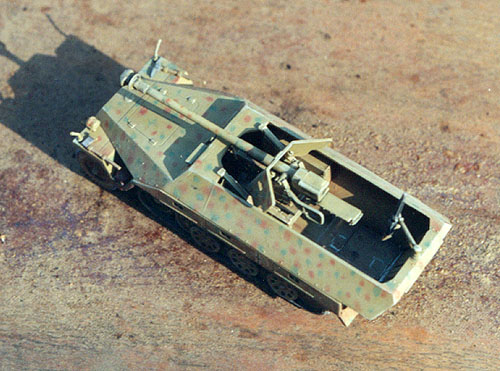
Kit
Weaknesses
- The
rear fighting compartment doors are molded as a single
piece, and need to be cut apart if you wish to have them
open. They are also not large enough to completely fill
the rear opening, so there is a gap either above or
beneath the doors. I tried to center mine to minimize the
gap on either side.
- The
fit of many of the hull components can be tricky, so
remember to constantly dry-fit as you go along.
- There
are no figures or stowage items included.
- The
decals, although printed in register, are too thick. Even
after several layers of dullcoat, there is a noticeable
edge around the carrier film, an edge that catches the
chalk dust I used for weathering.

Kit
Mediocrities
- Although
the interior has a fair amount of detail, I have heard
complaints from others that it is still missing
substantial amounts of detail. I don't know what is
missing, since I was unable to locate any interior photos
of this particular version of the half-track.
- I
haven't made up my mind about the tracks. They are molded
in soft vinyl, and the interior surfaces are not well
detailed. However, the exterior surfaces are very well
detailed. They were very easy to attach to the kit.
Hasegawa attached the wheels to a separate part with the
axle detail, which is then glued to the hull. This works
very well, and allows for easy gluing and painting of the
wheels and tracks. Usually, I prefer hard plastic tracks
because it's easier to glue them, and the paint stays
affixed to them after many years. I glued these tracks
together with Tenax-7R, which worked very well, and so
far the paint has adhered well. Time will tell if they
remain that way. I had to glue the track to the tops of
the wheels with superglue. I placed heavy objects on the
tops of the tracks as the glue dried. Again, time will
tell if the glue will hold.
- I am
not sure if this is a common problem, but in my kit the
left track was slightly longer than the right, and was a
little too long to fit snugly around the rear idler
wheel. Was one of my track pieces stretched? Or were the
wheels on the left side slightly closer to one another?
- The
axe on the left fender was a separate part, but the
pick-axe on the right fender had the axe head molded to
the fender piece, while the handle was a separate part.
Unusual.
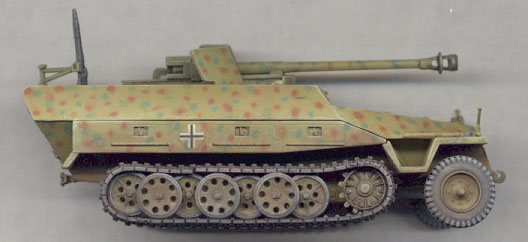
In all, I
am very pleased with this kit. It was quite simple to build, it's
very accurate, and the final result looks very good. It's
important to note that this 251/22 kit is identical to the 251/1
kit, but with an additional sprue of parts for the PAK 40. So, if
you are looking for only a 251/1 kit, you might be better off
buying this one, and keeping the PAK 40 for other conversion
projects.

References:
SdKfz 251, Wydawnictwo
Militaria No. 12, by Janusz Ledwoch; and SdKfz
251 Half-Track, 1939-1945, Osprey New
Vanguard No. 25, by Bruce Culver and Jim Laurier.
